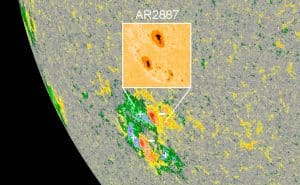
On Halloween weekend, some parts of the continental US were able to see the Northern Lights. Even folks in Kansas, including me, were able to see the lights low on the northern horizon. As far as I can tell, the last time folks were able to see the Northern Lights this far south was in 2003. Around Halloween that year, the Northern Lights were able to be seen as far south as Florida!
This year’s spectacular natural light show was brought to us by a solar flare that was launched at Earth from sunspot AR2887 on October 28. This flare launched a billion tons of star stuff and a magnetic field right at Earth in what scientists call a Coronal Mass Ejection (CME) at an amazing 2.5 to 3.3 million miles per hour! Even going that fast it still took two days to get to us from the Sun and slammed into the Earth for a full day straight! It is this star stuff and magnetic energy that causes the lights at the north and south poles.
Beyond causing some beautiful aurorae around the world, solar flares can also come with some nasty consequences. This year’s solar flare caused radios to stop working in most of South America for about an hour. A 2003 Halloween solar flare caused damage to some of the satellites orbiting Earth and was even linked to a blackout in Sweden! Airplanes that normally would go near the poles were forced to reroute through lower altitudes.
In case you haven’t guessed by now, I think space and space weather are fascinating. When I first learned that there was weather in space around 4th grade, I spent the next month reading and watching as much as my mom would allow about space weather. I learned that within the solar system, the Sun drives the space weather that has the most effect on us and our daily lives. Space weather doesn't always bother us on Earth but there have been times where space weather has had dramatic effects on our society. In September of 1859, a solar flare caused telegraph systems to fail, injuring some telegraph operators, and damaged electrical grids all over the world. The Northern Lights could be seen as far south as Cuba and were so bright in the Rocky Mountains that miners woke up thinking it was already morning. If you want to see daily forecasts for space weather, the NOAA Space Weather Enthusiast Dashboard is a great place to start.
Besides satellites and telescopes like Hubble (and soon the James Webb Space Telescope!), you would think the astronauts on the ISS are in more danger from solar flares than those of us on the ground. The truth is, the folks up on the ISS are in more danger from cosmic rays from outside of our solar system than the flares that come from our Sun! Solar flares are actually easily blocked by plastics and metals like aluminum, but exposure to cosmic rays can result in DNA damage that can eventually lead to cancer and other illnesses. The Earth’s magnetic field protects us on the ground and even partially protects the ISS. The magnetically charged particles ejected from the Sun during solar flares actually gives astronauts extra protection from harmful space radiation. Want to learn more?
In this book, Carl Sagan talks about his belief that exploring space and settling other planets is necessary for the survival of humanity and what a future like this might look like.
Discover some quick facts about the Sun, the most important part of our Solar System
Astrophysics for Young People in A Hurry
A walkthrough of Astrophysics for younger audiences written by Neil deGrasse Tyson


Add a comment to: Aurorae, and Sun Spots, and Flares (oh my)!